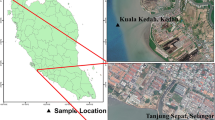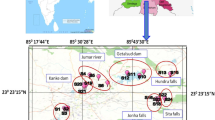Abstract
Concerns over human health safety from consumption of fishes originating from Kuantan river remain urgent due to recent rapid anthropogenic activities surrounding Kuantan river including bauxite mining. Health risk assessment is an important tool to evaluate the consequences of human activities and weighs the adverse effects to public health against the contributions to economic development. This study is aimed to estimate the target hazard quotient (THQ) and Target Hazard Index (THI) of heavy metals from commercially important and highly consumed fish species among Kuantan communities. Samples of Sebarau (Hampala macrolepidota), Lampam sungai (Barbonymus schwanenfeldii), and Lampam jawa (Barbonymus gonionotus) were caught by using fishnet gills along Kuantan river between June 2019 and December 2019. The fish were then digested and analyzed using Inductively Coupled Plasma – Mass Spectrometry (ICP-MS). The results revealed that the levels of eight metals (mg/kg) in all fish samples were ranked accordingly to their concentration in descending order of Al > Fe > Zn > Cu > Ni > As > Pb > Cd, suggesting that all the freshwater fishes in Kuantan river were contained with heavy metals. The average concentrations of Al, Fe, Zn, and Cd were the highest in H.macroleidota which were (50.0 ± 8.33, 35.25 ± 1.80, 4.58 ± 3.80, and 0.057 ± 0.018) mg/kg. Moreover, the average concentrations of Cu and Pb were the highest in B.gonionotus which were 4.23 ± 0.23 and 0.63 ± 0.10 and Ni concentrations were found the highest in B.shwanenfeldii (0.34 ± 0.35 mg/kg), respectively. However, metals concentration in all fishes were below the permissible limit stipulated by the World Health Organizations (WHO) (1985), the Food and Agriculture Organization FAO (2003), and the Malaysian Food Act 1983. It was also noticed that consumption of all fishes may bring about health risks from different metals as indicated by varied THI values. Consumption of the three species was noticed to promote high health risk from As intoxication as the HQ for As was >1.00. Hence, health risk assessment is required in order to determine the probability of human health risk due to heavy metals following the consumption of fish originating from a collection site. A lot of studies on heavy metal pollution by bauxite mining have been done by many researchers, but few studies have been published related to health risk assessment on heavy metal pollution based on fish consumption.
Access this chapter
Tax calculation will be finalised at checkout
Purchases are for personal use only
Similar content being viewed by others
References
Ahdy HHH, Abdallah AMA, Tayel FT (2007) Assessment of heavy metals and nonessential content of some edible and soft tissues. Egypt J Aquat Res 33:85–97
Ahmed MK, Baki MA, Kundu GK, Islam MS, Islam MM, Hossain MM (2016) Human health risks from heavy metals in fish of Buriganga river, Bangladesh. Springerplus 5(1):1697
Amiard JC, Amiard-Triquet C, Berthet B, Metayer C (1987) Comparative study of the patterns of bioaccumulation of essential (Cu, Zn) and non-essential (Cd, Pb) trace metals in various estuarine and coastal organisms. J Exp Mar Biol Ecol 106(1):73–89
AOAC (2016) Official methods of analysis of AOAC INTERNATIONAL, 20th edn. Association of Official Analytical Chemists, Washington, DC
APHA (2005) Standard methods for the examination of water and wastewater analysis. American Water Works Association/Water Environment Federation, Washington, DC, p 289
APHA (2017) Standard methods for the examination of water and wastewater analysis, 23rd edn. American Public Health Works Association, Washington, DC AC Bosch B O’Neill GO Sigge SE Kerwath LC Hoffman 2016 Heavy metals inmarine fish meat and consumer health: a review J Sci Food Agric 96 32 48
ATSDR U (2004) Interaction Profile for Lead, Manganese, Zinc, and Copper. 2018-10-12
Bosch AC, O’Neill B, Sigge GO, Kerwath SE, Hoffman LC (2016) Heavy metals inmarine fish meat and consumer health: a review. J Sci Food Agric 96:32–48
Burger J, Gochfeld M (2009) Perceptions of the risks and benefits of fish consumption: Individual choices to reduce risk and increase health benefits. Environ Res 109(3):343–349
Food and Agriculture Organisation (FAO) (2003) Heavy metals Regulations-Faolex. Legal Notice no. 66/2003
Díez S, Delgado S, Aguilera I, Astray J, Pérez-Gómez B, Torrent M, ... Bayona JM (2009) Prenatal and early childhood exposure to mercury and methylmercury in Spain, a high-fish-consumer country. Arch Environ Contam Toxicol 56(3):615–622
Djedjibegovic J, Larssen T, Skrbo A, Marjanovic A, Sober M (2012) Contents of cadmium, copper, mercury and lead in fish from the Neretva river (Bosnia and Herzegovina) determined by inductively coupled plasma mass spectrometry (ICPMS). Food Chem 131(2):469–476
DOE (2017) Environmental quality report 2017. Department of Environment, Ministry of Science, Technology and Environment, Putrajaya
Griboff J, Wunderlin DA, Monferran MV (2017) Metals, As and Se determination by inductively coupled plasma-mass spectrometry (ICP-MS) in edible fish collected from three eutrophic reservoirs. Their consumption represents a risk for human health?. Microchem J 130:236–244
Han B-C, Jeng W-L, Hung T-C, Jeng M-S (1994) Copper intake and health threat by consuming seafood from copper-contaminated coastal environments in Taiwan. Environ Toxicol Chem 13:775–780
Jakimska A, Konieeczka P, Skora K, Namiesnik J (2011) Bioaccumulation of metals in tissues of marine animals partII: metal concentration in animal tissues. Pol J Environ Stud 20(5):1127–1146
Jamil T, Lias K, Norsila D, Syafinaz NS (2014) Assessment of heavy metal contamination in squid (Loligo Spp.) Tissues of kedah-perlis waters, Malaysia. Malaysia J Anal Sci 18:195–203
Jezierska B, Witeska M (2006) The metal uptake and accumulation in fish living in polluted waters. In Soil and water pollution monitoring, protection and remediation (pp. 107–114). Springer, Dordrecht
Kamaruzzaman BY, John BA, Megat MA, Zaleha K (2011) Bioaccumulation of heavy metals in horseshoe crabs (Tachypleus gigas) from Pekan, Pahang, Malaysia. Res J Environ Toxicol 5(3):222
Kraak MHS, Wink YA, Stuyfzand C, Buckert-de Jong MC, de Grootand CJ, Admiraal W (1994) Chronic ecotoxicity of zine and lead to zebra mussel Dreissena polymorpha. Aquat Toxicol 30:77–89
Krantzberg G, Stokes PM (1989) Metal regulation, tolerance, and body burdens in larvae of the genus Chironomus. Can J Fish Aquat Sci 46:389–398
Kusin FM, Zahar MSM, Muhammad SN, Mohamad ND, Zin ZM, Sharif SM (2016) Hybrid off-river augmentation system as an alternative raw water resource: the hydrogeochemistry of abandoned mining ponds. Environ Earth Sci 75(3):1–15
Liao CM, Ling MP (2003) Assessment of human health risks for arsenic bioaccumulation in tilapia (Oreochromis mossambicus ) and large-scale mullet (Liza macrolepis) from blackfoot disease area in Taiwan. Arch Environ Contam Toxicol 45:264–272
Mansour SA, Sidky MM (2002) Ecotoxicological studies. 3. Heavy metals contaminating water and fish from Fayoum Governorate, Egypt. Food Chem 78(1):15–22
Mmolawa KB, Likuku AS, Gaboutloeloe GK (2010) Reconnaissance of heavy metal distribution and enrichment around Botswana. Fifth international conference of environmental science & technology, Houston, Texas, USA, 12–16 July 2010
Pérez-López R, Álvarez-Valero AM, Nieto JM, Sáez R, Matos JX (2008) Use of sequential extraction procedure for assessing the environmental impact at regional scale of the São Domingos Mine (Iberian Pyrite Belt). Appl Geochem 23:3452–3463
Rohasliney H, Song TH, Zuhartini NMM, Yen TP (2014) Determination of heavy metal levels in fishes from the lower reach of the Kelantan River, Kelantan, Malaysia. Tropical Life Sciences Research 25(2):21–39
Saha N, Mollah MZI, Alam MF, Rahman MS (2016) Seasonal investigation of heavy metals in marine fishes captured from the Bay of Bengal and the implications for human health risk assessment. Food Control 70:110–118
Svensson BG, Nilsson A, Jonsson E, Schütz A, Akesson B, Hagmar L (1995) Fish consumption and exposure to persistent organochlorine compounds, mercury, selenium and methylamines among Swedish
TaTaweel A, Shuhaimi-Othman M, Ahmad AK (2013) Assessment of heavy metals in tilapia fish (Oreochromis niloticus) from the Langat River and Engineering Lake in Bangi, Malaysia, and evaluation of the health risk from tilapia consumption
Terra BF, Araujo FG, Calza CF, Lopes RT, Teixeira TP (2008) Heavy metal in tissue of three fish species from different trophic levels in a tropical Brazilian river. Water Air Soil Pollut 19. https://doi.org/10.1007/s11270-007-9515-9
USEPA (2003) Water quality criterion for the protection of human health: methylmercury, edited
White SL, Rainbow PS (1982) Regulation and accumulation of Cu, Zn and Cd by the shrimp Palaemon elegans. Mar Ecol Prog Ser 8:95101
WHO (1985) Guidelines for drinking water quality (Recommendations). WHO Geneva
Acknowledgments
The research is supported by KPT Grant FRGS/1/2016/Wab05/UNISZA/03/1.
Author information
Authors and Affiliations
Corresponding author
Editor information
Editors and Affiliations
Rights and permissions
Copyright information
© 2022 The Author(s), under exclusive license to Springer Nature Switzerland AG
About this chapter
Cite this chapter
Yaakub, N., Rohalin, W.M. (2022). Human Health Risk Assessment of Heavy Metals Exposure Due to Selected Freshwater Fishes Ingestion from Sungai Kuantan, Malaysia. In: Samah, M.A.A., Kamarudin, M.K.A. (eds) Environmental Management and Sustainable Development. Springer, Cham. https://doi.org/10.1007/978-3-030-93932-8_2
Download citation
DOI: https://doi.org/10.1007/978-3-030-93932-8_2
Published:
Publisher Name: Springer, Cham
Print ISBN: 978-3-030-93931-1
Online ISBN: 978-3-030-93932-8
eBook Packages: Earth and Environmental ScienceEarth and Environmental Science (R0)




